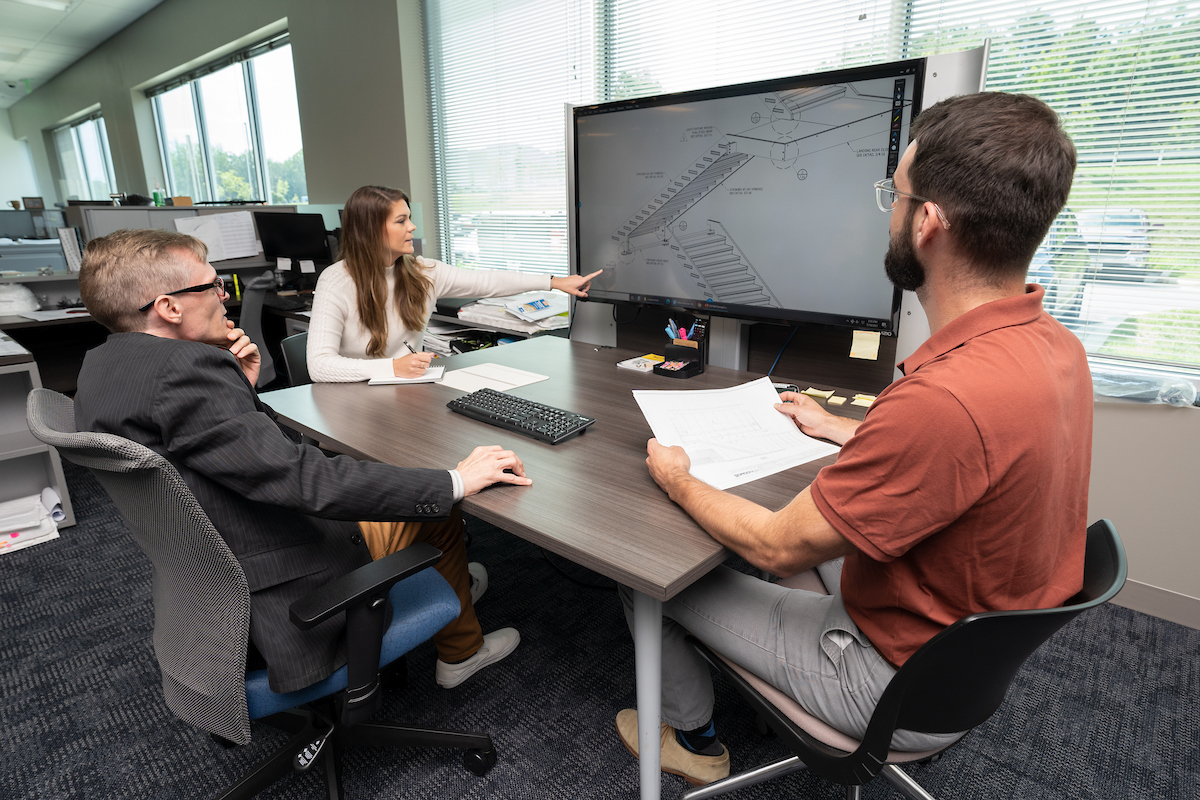Architectural
Feature Stairs: A Champion of Active Design
Architects and designers today have the ability to play a crucial role in combating the “inactivity epidemic”. By incorporating active design strategies - such as prominently placed and inviting feature stairs into building design - the built environment can encourage occupants to take the stairs and incorporate physical activity into their daily routines, which can lead to improved physical health and well-being.
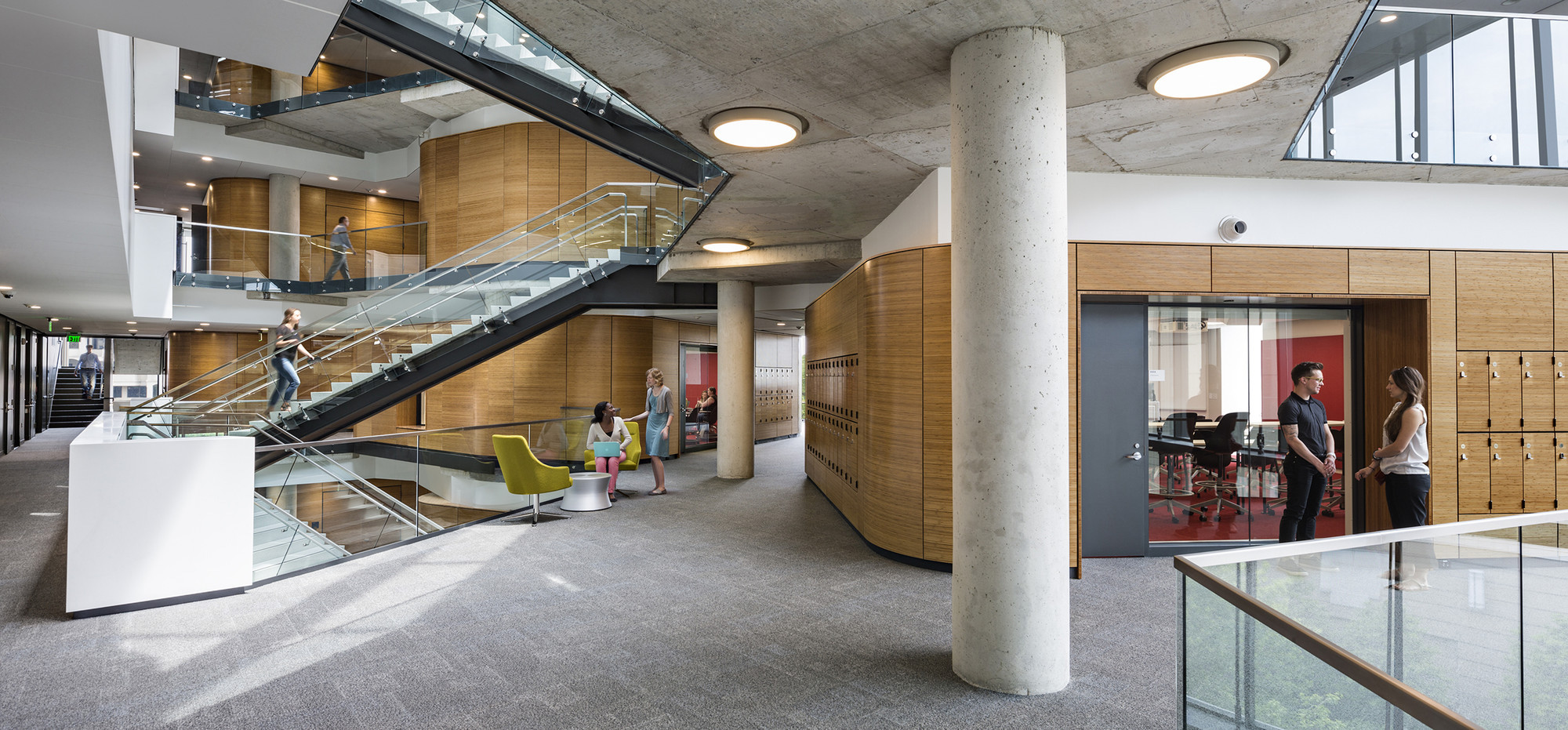
Feature stairs are not just functional; they are visually striking, capable of becoming an iconic element of the building’s design – one reason they are a favorite building element of many architects. Moreover, incorporating feature stairs into building design is a great way to promote physical activity and improve the well-being of building occupants. Active design principles focus on creating environments that promote physical activity, and feature stairs constitute one of the best examples of active design in action. By intentionally placing feature stairs in convenient and prominent locations, designers can encourage occupants to choose taking the stairs over elevators and escalators, which can lead to improved physical health and well-being.
Why We Need to Focus on Occupant Well-Being
The Inactivity Epidemic
Physical inactivity and unhealthy diets are significant contributors to premature death in the US. In recent years, there has been increasing attention to the role of the built environment in promoting physical activity and healthy lifestyles. Can the built environment be leveraged to increase active living? In short – yes. Architects have an important role to play in addressing today’s public health issues. Through the use of active design strategies, architects can create environments that incorporate physical activity into the daily routines of a building’s occupants.
What is Active Design and How Does It Improve Health?
Active design is a set of building and planning principles that promote physical activity. An architectural and urban planning movement, active design seeks to integrate physical activity into the everyday routines of a space’s occupants. Activity-friendly buildings can be created by integrating active design philosophies into a building’s circulation systems – especially its stairs and elevators. Other elements of active design include features such as bike lanes, walking paths, stairs, and other design elements that promote physical activity. Strategies can also incorporate features such as community gardens and healthy food options, which encourage healthy eating habits. By incorporating these features into building design, architects and building owners can help create environments that promote physical activity and healthy lifestyles. Thus, designers today have the ability to play a crucial role in combating the “inactivity epidemic”.
What Role do Stairs Play in the Active Design Movement?
Stairs – an Active Design Tool to Combat Inactivity
Incorporating physical activity opportunities into design can be an effective way to combat the obesity epidemic. An attractive and accessible option that encourages people to take the stairs and be more physically active, while also promoting social interaction and a sense of community within the building, feature stairs are an excellent example of active design. Actions like climbing stairs, getting up from a desk to use office equipment, or walking down a hallway may often constitute the most accessible and economical way for many to participate in regular physical activity. Because stairs are already present in almost every building and readily used without presenting any major lifestyle changes, stairs have a real potential – among all building elements – to effect accessible, effective, and economical health impacts. “We’re not asking people to go to the gym every day,” says architect (and stair enthusiast) David Burney, leader of the Center for Active Design’s governing board and former New York City commissioner of Design and Construction. “We’re trying to do this in a way that is seamless.”
Do They Have to be “Feature” Stairs? The Importance of Design
Increased stair use is one of the key ways architects can help building occupants incorporate physical activity into their daily routines and combat the rise of chronic health conditions like obesity, heart diseases, diabetes, and even mental health issues. But, according to an NPR article, in order for stairs to improve health, people have to play along – building the stairs is not enough; you have to get people to use them. The role and efficacy building elements have in remediating physical inactivity depends largely on their design. This includes designing stairs that are conveniently located, easily accessible, and safe to use, as well as promoting their use through signage, lighting, and other features.
Design is key to the link between physical activity opportunities and the built environment as an effective and relatively rapid intervention to the obesity epidemic. The design of stairs can either promote or deter activity through their availability, convenience, desirability, safety, and comfort. According to research based findings, poorly placed (difficult to access) stairs, non-ergonomic design, and elevators are just a few of the features that not only discourage physical activity but potentially neutralize other features designed to promote it. Furthermore, features like unneeded escalators, an overemphasis on elevators, and barriers like door locks, and poor placement of other building elements actually deter physical activity.
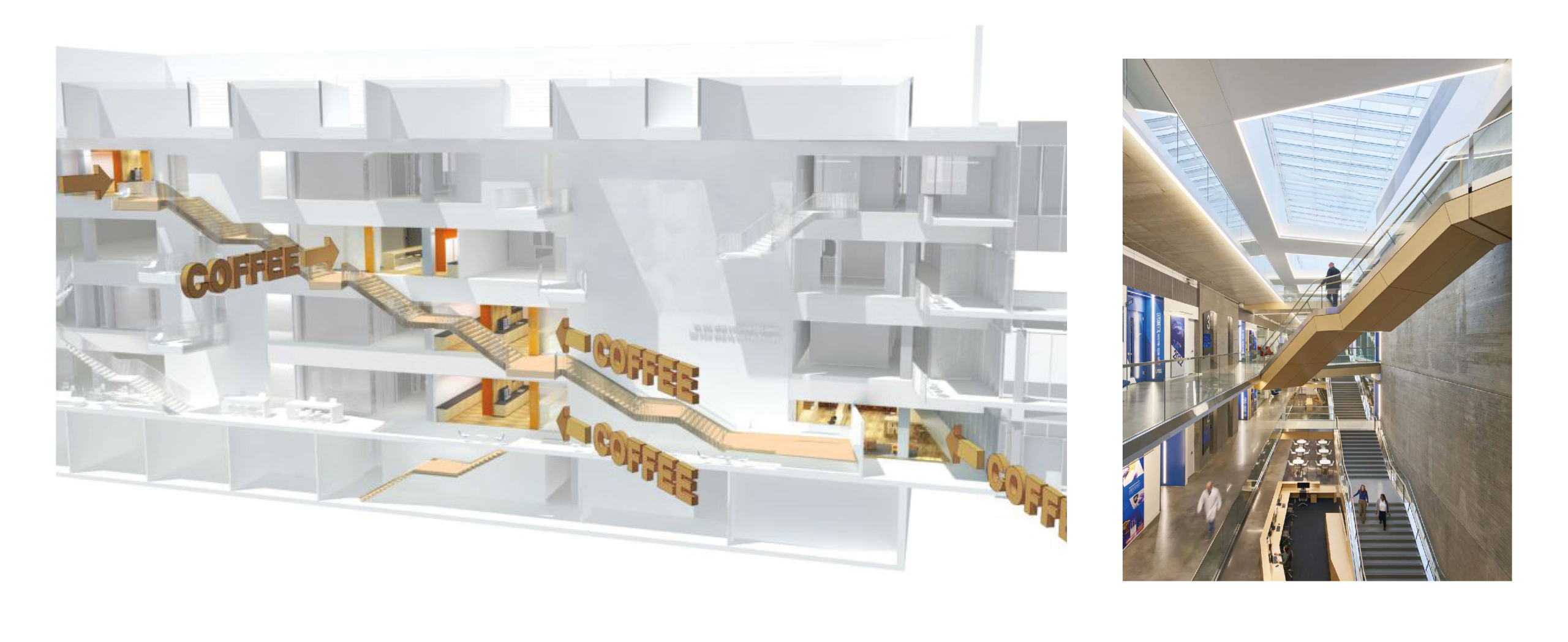
Prominent placement, striking design, and strategically placed coffee bars encourage occupants to make use of these stairs.
Can Stairs Really Make a Difference in Improving Occupants’ Wellbeing?
Health Benefits of Taking the Stairs
According to an American Journal of Preventative Medicine study, seven minutes of stair climbing a day over ten years halves the risk of a heart attack. The same study also found that just two minutes of stair climbing a day was enough to offset the average American’s middle-age weight gain (~one lb./year), and several have found relatively modest increases in stair use can have positive health and lifestyle effects. Other studies have also shown that even relatively modest increases in stair use can have positive health and lifestyle effects. This can lead to increased productivity and decreased absenteeism, as studies have shown that healthy employees are more engaged and less likely to miss work due to illness.
Added Benefits of Feature Stairs
As occupants increasingly take the stairs, physical and mental health improves throughout the workforce, which can lead to improved employee health, lower company healthcare costs, and increased interaction among departments. For example, according to an Architect Magazine article, stairs that are at least 96 inches wide encourage people to linger and interact, and the deep, bleacher-style structures increasingly popular in educational and auditorium spaces can double as seating for large events. When part of an overall well-designed space, stairs can also increase employee recruitment and retention. Moreover, feature stairs can also be used as a branding tool for the building, making it more recognizable and memorable to visitors. This can help to attract tenants and improve the building’s overall marketability.
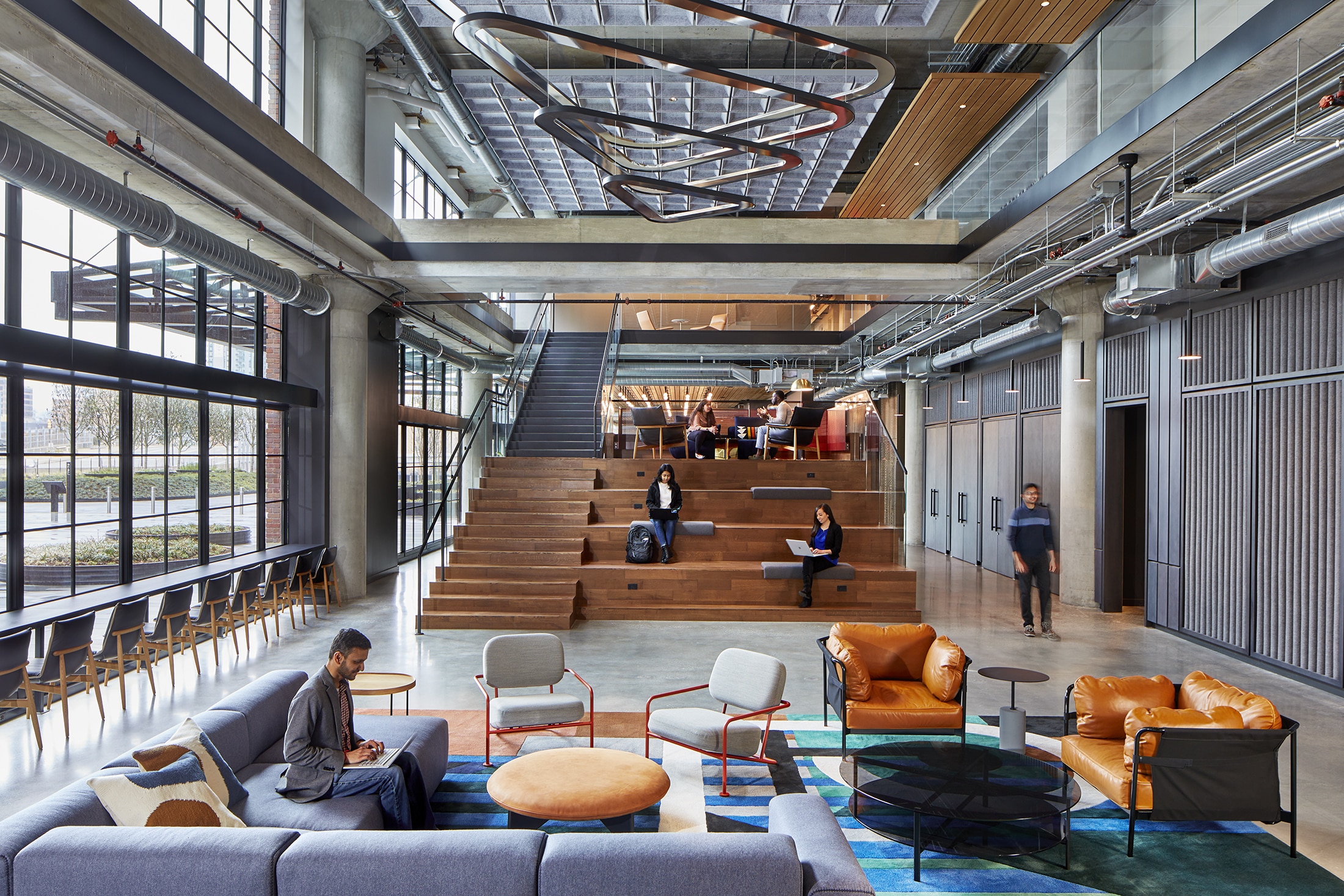
Employees at Microsoft’s Atlanta office gather and commune on the lobby’s wide feature stairs that offer bleacher style seating.
Feature Stairs in Today’s Architecture
Programs and Certifications Recognizing Active Design
In addition to the LEED certification program by the U.S. Green Building Council, several new certification programs promote active design strategies that encourage physical activity and healthy lifestyles. As occupants are increasingly looking to be more active at work, building owners are seeking out certifications from programs that go beyond simply promoting energy efficiency and environmental sustainability by focusing on creating buildings and spaces that support occupant health and well-being. The use of stairs is key to these programs.
One such program is Fitwel, which was created by the CDC and the General Services Administration (GSA) and is now managed by the Center for Active Design. Fitwel provides guidelines and strategies for promoting physical activity, healthy eating habits, and mental health in buildings and spaces. Its publication, Active Design Guidelines, is a manual for creating healthier building, streets, and urban spaces. Included in its suggestions for increasing stair use among the able-bodied are providing stairs for everyday use, actively encouraging stair use, and designing visible, appealing, and comfortable stairs.
Another certification program that promotes active design is the WELL Building Standard, which was created by the International WELL Building Institute (IWBI). The WELL standard focuses on creating buildings that support occupant health and well-being across seven categories: air, water, nourishment, light, fitness, comfort, and mind. The fitness category specifically promotes the use of active design strategies to encourage physical activity and improve health outcomes. Prominently featuring and giving people access to stairs is a key aspect of WELL; it encourages occupants to move about, socialize, and stay fit. WELL Fitness Feature 64, for example, recognizes designs that encourage occupants to be active indoors with “accessible, safe, and visually appealing stairs, entryways, and corridors.”
Our Takeaway: Encourage Active Design with Feature Stairs
Architects today can help building occupants incorporate physical activity into their daily routines through active design – evidence-based architectural and urban planning strategies to increase regular physical activity through design. Over the last decade, much emphasis has been placed on architecture’s ability to affect the well-being of building occupants, including physical well-being. By taking into account the needs and preferences of users and designing for physical activity, designers can help promote healthier lifestyles and combat the negative effects of sedentary behavior. Building owners are increasingly compelled to invest in features that provide more than function.
Addressing the goals of function, form, and fitness, feature stairs are a multi-faceted tool that create value for designers, developers, and occupants alike. Drawing upon the principles of active design, feature stairs activate spaces by intentionally drawing people away from elevators and escalators, promoting the health and well-being of building occupants. By incorporating active design strategies, such as prominently placed and inviting stairs, into building design, architects and designers can create environments that encourage occupants to take the stairs and incorporate physical activity into their daily routines. This can have significant health and productivity benefits, making feature stairs a win-win for building owners, occupants, and society as a whole. By promoting physical activity, improving well-being, and enhancing the building’s aesthetic appeal, feature stairs are an essential element of modern building design.
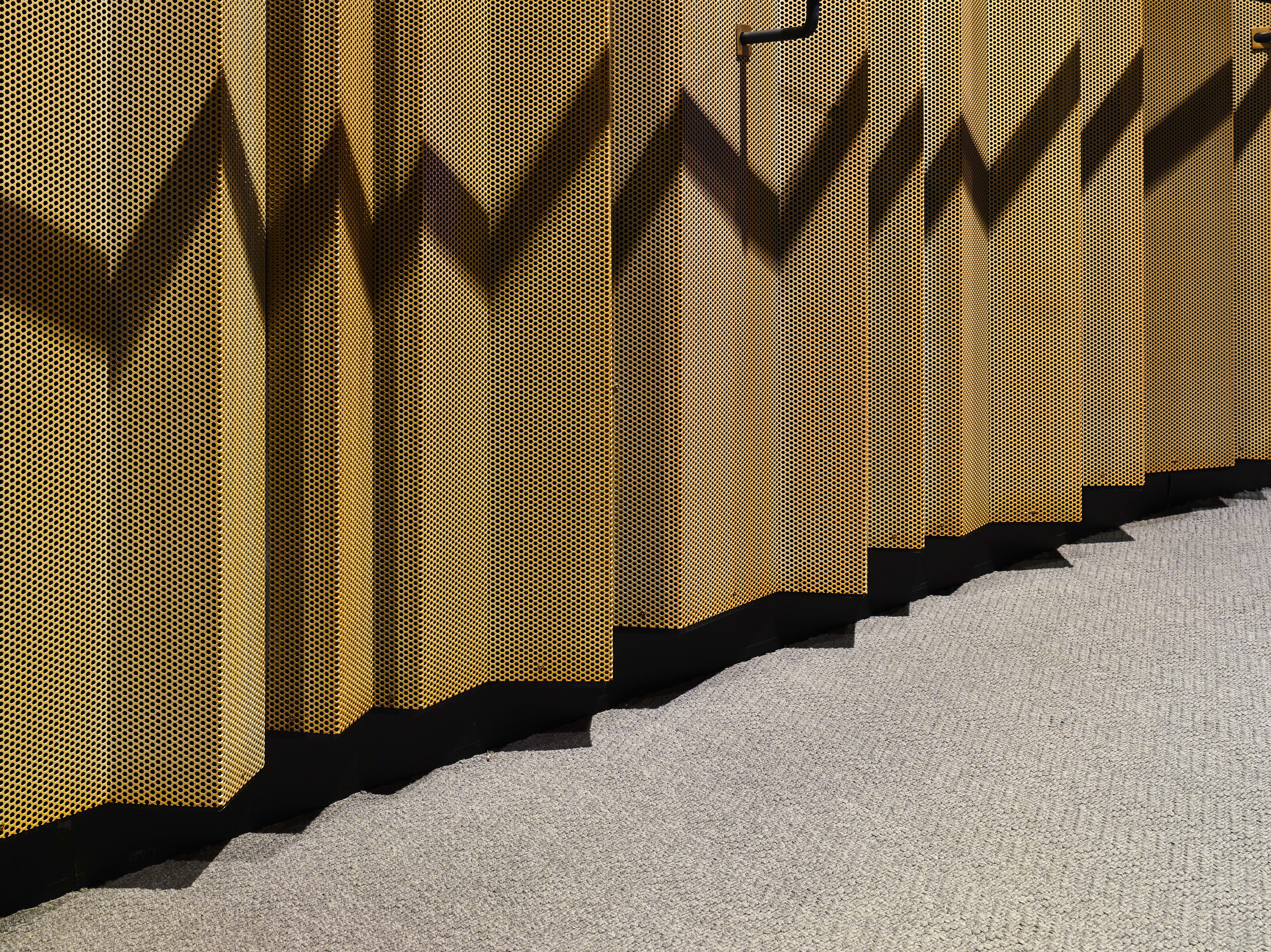
Six Benefits Of Using Perforated Metal In Stair Design
